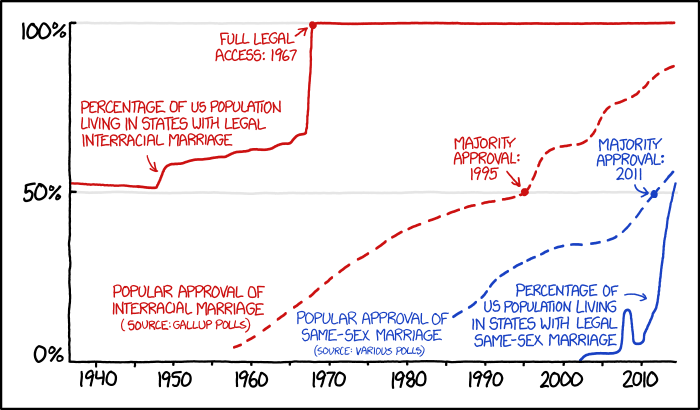A few days ago, a student referred me to the following graph:
The graph raises two questions for me. The first and most glaring question is the gap between the red lines, between public opinion on interracial marriage and the percentage of people who lived in states that allowed the practice. To be sure, this explains Naim v. Naim and the Court's refusal to strike down anti-miscegenation laws as discordant with Brown and equal protection. But what it does not explain is the Court's decision in Loving, which struck down these laws in the 16 states that still had laws in the books against interracial marriage. It seems the case cannot be explained by pointing to public opinion in 1967. It also cannot be explained as a time when the Court rounded up a few remaining outliers.
Could the case be explained by invoking morality and constitutional principles? If not, what is left?
The second question focuses on the lag between opinion on marriage equality the number of states approving the practice. That the blue lines are about to meet sometime soon tells us something important about the rapidity with which the marriage equality debate has moved in the last few years. To me, the question is: what accounts for that change? Can we explain it simply by pointing to social movement theory?
This leads me to a third question, about which I will have much more to say in a future post: why did the Court hesitate last week and decide against entering the marriage equality debate? To enter the debate would be to side with a majority of the American public. It is also true that a majority of the population now live in states that issue marriage licenses to same-sex couples. The writing is clearly on the wall. So why wait? How strong must public opinion be on this question? How many outliers must remain?
Part of the answer must be that we misunderstand what the Court is, what it does, and what it can do. We have a romantic view, fostered by the media and taught in many law schools, of the Court as a countermajoritarian hero. This is not an accurate view of the Court and its work. The Court is far from a fearless defender of the rights of minorities. In fact, the Court seldom leads public opinion but follows it. Rather than looking at the Court's hesitation from last week and asking why it chose not to decide, the better question is: how much more will it take for the Court to get in the marriage equality debate?

No comments:
Post a Comment